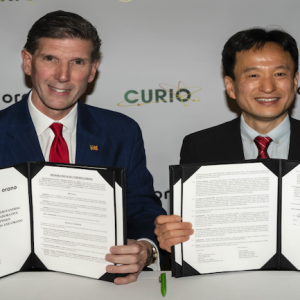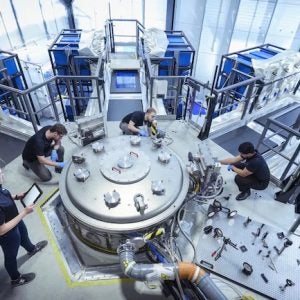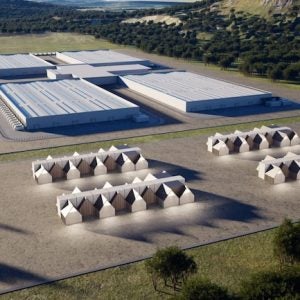Cold hydrostatic testing (CHT) began on 22 May at unit 1 of China’s Sanmen NPP in Zhejiang province, China Nuclear Engineering and Construction Corporation (CNEC) announced. The tests involve filling the reactor’s primary circuit with water, which is circulated by the reactor coolant pumps to verify that the welds, joints, pipes and components of the reactor coolant system and associated high-pressure systems meet regulatory standards. CNEC said the tests mark the beginning of the commissioning phase of the AP1000. The CHT prepares the way for hot functional test and initial fuel load.
Also in May, the 215t integrated head package was installed on top of the AP1000 reactor pressure vessel of unit 1 of the Haiyang NPP in Shandong province, plant constructor State Nuclear Power Technology Corporation (SNPTC) announced. The integrated head package combines several separate components in one assembly and aims to allow the rapid removal of the reactor vessel head during a refuelling outage. It includes a lifting rig, seismic restraints for control rod drive mechanisms, support for reactor head vent piping, power cables, cables and a conduit for in-core instrumentation, cable supports and the cooling shroud assembly. Mounted directly on the reactor vessel head, the system helps to minimize the time, manpower and radiation exposure associated with head removal and replacement during refuelling.
Four AP1000 reactors are under construction in China, two each at Sanmen and Haiyang. Sanmen 1 is expected to be the first AP1000 to begin operating, in September, while Haiyang 1 is expected to start up by the end of the year. Containment tests have already been successfully conducted at both units. All four Chinese AP1000s are scheduled to be in operation by the end of 2017.
Elsewhere in China, first fuel loading has been completed at unit 2 of the Fangchenggang NPP, a Chinese design CPR-1000 reactor, in Guangxi province, project owner China General Nuclear (CGN) announced on 25 May. Fangchenggang 2 will now undergo pre-operational tests before entering commercial operation scheduled for the second half of 2016. Fangchenggang 1, also a CPR-1000, entered commercial operation in January. The Fangchenggang nuclear station will have four reactors – two CPR-1000s and two Hualong One units. Construction of Fangchenggang-3 has begun, with the first pouring of nuclear concrete in December 2015. Fangchenggang 3 and 4 will use the same design.
Work has also started on the containment building of unit 6 at the Fuqing NPP in Fujian province – another Hualong One reactor. The first steel lining module for the containment building has been installed, plant builder CNEC announced on 25 May. In November 2014, plant owner China National Nuclear Corporation (CNNC) announced that units 5 and 6 at Fuqing would use the domestically-developed Hualong One reactor design rather than the previously planned ACP1000 design. The pouring of first concrete for the reactor basemats for Fuqing 5 and 6 took place in May and December 2015, respectively. Fuqing 5 and 6 are scheduled to be completed in 2019 and 2020.
Earlier in May, cold testing was completed at unit 4 of the Yangjiang NPP in Guangdong province, China General Nuclear Power Corporation (CGN) said. Cold testing involves increasing the pressure inside the unit’s primary circuit to 22.8 megapascals, which is the highest pressure components will have to withstand during normal operation. The cold function test is the first in a series of comprehensive tests that form part of the plant’s commissioning phase, CGN said. There are three commercially operational units at the Yangjiang and three more under construction. Yangjiang 1-4 are CPR1000s, while Yangjiang 5 and 6 are ACPR1000s.
Meanwhile, China Nuclear Industry 23 Construction Company (CNI 23)has won a tender to construct the nuclear islands for units 5 and 6 of the Tianwan NPP in Jiangsu province, CNEC announced on 18 May. CNI 23 submitted the tender documents on 5 April and a contract will be signed with China Nuclear Power Engineering Company soon, CNEC said. It noted that this is the fourth tender that CNI 23 has won so far this year to build nuclear power reactors.






